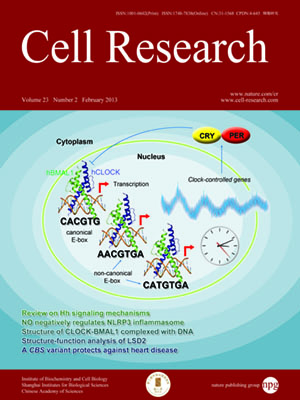
Volume 23, No 2, Feb 2013
ISSN: 1001-0602
EISSN: 1748-7838 2018
impact factor 17.848*
(Clarivate Analytics, 2019)
Volume 23 Issue 2, February 2013: 242-253
ORIGINAL ARTICLES
A functional variant in the cystathionine β-synthase gene promoter significantly reduces congenital heart disease susceptibility in a Han Chinese population
Jian-Yuan Zhao1,7,*, Xue-Yan Yang1,*, Kai-Hu Shi2,*, Shu-Na Sun3, Jia Hou3, Zhi-Zhou Ye1, Jue Wang1, Wen-Yuan Duan4, Bin Qiao4, Yi-Jiang Chen5, Hong-Bing Shen6, Guo-Ying Huang3, Li Jin1,8 and Hong-Yan Wang1,3,8
1The State Key Laboratory of Genetic Engineering and MOE Key Laboratory of Contemporary Anthropology, School of Life Sciences, Fudan University, 220 Handan Road, Shanghai 200433, China
2The Second Hospital of Anhui Medical University, 678 Furong Road, Hefei, Anhui 230601, China
3Children's Hospital of Fudan University, 399 Wanyuan Road, Shanghai 201102, China
4Institute of Cardiovascular Disease, General Hospital of Jinan Military Region, 8 Lashan Road, Jinan, Shandong 250022, China
5Department of Thoracic and Cardiovascular Surgery, The First Affiliated Hospital of Nanjing Medical University, 140 Hanzhong Road, Nanjing, Jiangsu 210029, China
6Department of Epidemiology and Biostatistics, School of Public Health, Nanjing Medical University, 140 Hanzhong Road, Nanjing, Jiangsu 210029, China
7Institute of Sports Science and Technology, Administration of Sports of Anhui Province, 97 Wuhu Road, Hefei, Anhui 230001, China
8The Institutes of Biomedical Sciences, Fudan University, 138 Yixueyuan Road, Shanghai 200032, China
Correspondence: Hong-Yan Wang,(wanghy@fudan.edu.cn)
Homocysteine is an independent risk factor for various cardiovascular diseases. There are two ways to remove homocysteine from embryonic cardiac cells: remethylation to form methionine or transsulfuration to form cysteine. Cystathionine β-synthase (CBS) catalyzes the first step of homocysteine transsulfuration as a rate-limiting enzyme. In this study, we identified a functional variant −4673C>G (rs2850144) in the CBS gene promoter region that significantly reduces the susceptibility to congenital heart disease (CHD) in a Han Chinese population consisting of 2 340 CHD patients and 2 270 controls. Individuals carrying the heterozygous CG and homozygous GG genotypes had a 15% (odds ratio (OR) = 0.85, 95% confidence interval (CI) = 0.75-0.96, P = 0.011) and 40% (OR = 0.60, 95% CI = 0.49-0.73, P = 1.78 × 10−7) reduced risk to develop CHD than the wild-type CC genotype carriers in the combined samples, respectively. Additional stratified analyses demonstrated that CBS −4673C>G is significantly related to septation defects and conotruncal defects. In vivo detection of CBS mRNA levels in human cardiac tissues and in vitro luciferase assays consistently showed that the minor G allele significantly increased CBS transcription. A functional analysis revealed that both the attenuated transcription suppressor SP1 binding affinity and the CBS promoter hypomethylation specifically linked with the minor G allele contributed to the remarkably upregulated CBS expression. Consequently, the carriers with genetically increased CBS expression would benefit from the protection due to the low homocysteine levels maintained by CBS in certain cells during the critical heart development stages. These results shed light on unexpected role of CBS and highlight the importance of homocysteine removal in cardiac development.
Cell Research (2013) 23:242–253; doi:10.1038/cr.2012.135; published online 18 September 2012
FULL TEXT | PDF
Browse 2301


